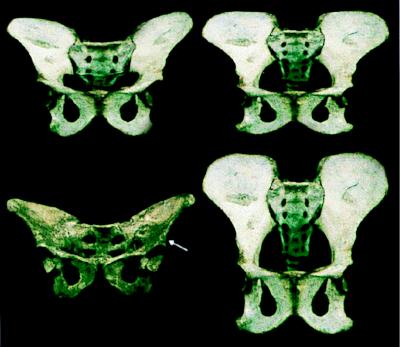Figure 1.
Hypothetical transitional emergence of the hominid pelvis. Anterior photographs of a chimpanzee pelvis (lower right) and that of A.L. 288-1 (“Lucy”) (lower left) were scanned. Using a sliding scale, the upper left image was then obtained by digital morphing to a transitional stage 75% of the distance between the chimpanzee and A.L. 288-1. The upper right image is a simple superoinferior digital distortion of the chimpanzee without any reference to a known “end product” (Photoshop “scale function”). Image breadth was not altered; its superoinferior height was simply reduced by 2/3. (Note: the upper right image appears somewhat less “transitional” than the one at the upper left because the latter benefits from the three-dimensionality of the two images being morphed; i.e., our distortion was only two-dimensional.) We do not suggest that either image constitutes an actual “intermediate” pelvic form. We wish only to demonstrate that a simple dimensional change in one hypothetical adult form is very similar to that which has been morphed by using the known adult “final outcome” and that it might be achieved by a simple underlying mechanism such as a progressive increase or decrease in the slopes of cell response gradients (see text). We suggest that this is the most probable morphogenetic mode by which the many anatomical differences between A.L.-288-1 and the chimpanzee pelves evolved. Therefore, the isolated definition and separate analysis of each of the many traits that differ between these pelves is likely to greatly distort their functional and phyletic significance (see especially ref. 7, pp. 359–361 for discussion). Note, for example, that a number of the unusual distinguishing characters of the australopithecine pelvis, including its exceptionally broad sacrum, platypelloid birth canal (i.e., anteroposterior dimension/mediolateral dimension × 100 ≈ 50–60), short pubic symphysis, elongated superior and inferior pubic rami, ovoid obturator foramina, etc., have all been reproduced by this simple, relatively crude, linear distortion.

